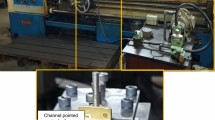Abstract
The turn-milling methods for machining operation have been developed to increase efficiency of conventional machines recently. These methods are used especially by coupling some apparatuses on the computer numerical control (CNC) machine to decrease the production time and machine costs, ensure the maximum production and increase the quality of machining. In this study, 100Cr6 bearing steel extensively used in industry has been machined by tangential turn-milling method. This paper presents an approach for optimization of the effects of the cutting parameters including cutter speed, workpiece speed, axial feed rate, and depth of cut on the surface roughness in the machining of 100Cr6 steel with tangential turn-milling method by using genetic algorithm (GA). Tangential turning-milling method has been determined to have optimum effects of cutting parameters on the machining of 100Cr6 steel. The experimental results show that the surface roughness quality is close to that of grinding process.






Similar content being viewed by others
References
Kountanya R, Al-Zkeri I, Altan T (2009) Effect of tool edge geometry and cutting conditions on experimental and simulated chip morphology in orthogonal hard turning of 100Cr6 steel. J Mater Process Technol 209:5068–5076
Umbrello D (2011) Influence of material microstructure changes on surface integrity in hard machining of AISI 52100 steel. Int J Adv Manuf Technol 54(9):887–898
Mao C, Zhou Z, Zhang J et al (2011) An experimental investigation of affected layers formed in grinding of AISI 52100 steel. Int J Adv Manuf Technol 54(5–8):515–523
Mulik RS, Pandey PM (2011) Magnetic abrasive finishing of hardened AISI 52100 steel. Int J Adv Manuf Technol 55(5):501–515
Savas V, Ozay C (2008) The optimization of the surface roughness in the process of tangential turn-milling using genetic algorithm. Int J Adv Manuf Technol 37:335–340
Savas V, Ozay C (2007) Analysis of the surface roughness of tangential turn-milling for machining with end milling cutter. J Mater Process Technol 186:279–283
Savas V, Ozay C (2009) Researching the effects of cutting parameters obtained from MS58 Brass tangential turning-milling processes on surface roughness. Electron J Mach Technol Cover 6(4):65–70
Karaguzela U, Bakkal M, Budak E (2012) Process modeling of turn-milling using analytical approach. In: 3rd CIRP conference on process machine interactions (3rd PMI), Procedia CIRP 4:131–139
Mahesh G, Muthu S, Devadasan SR (2015) Prediction of surface roughness of end milling operation using genetic algorithm. Int J Adv Manuf Technol 77:369–381
Zhu L, Li H, Wang W (2013) Research on rotary surface topography by orthogonal turn-milling. Int J Adv Manuf Technol 69:2279–2292
Budak E, Armarego EJA, Altintas Y (1996) Prediction of milling force coefficients from orthogonal cutting data. J Eng Ind 118(2):216–224
Altintas Y (2012) Manufacturing automation: metal cutting mechanics, machine tool vibrations, and CNC design, seconded. Cambridge University Press, New York
Yuan SM, Zheng WW (2012) The surface roughness modeling on turn-milling process and analysis of influencing factors. Appl Mech Mater 117:1614–1620
Zhu L, Tang L, Su C et al (2008) Co-simulation of rigid-flexible coupling system for turn-milling center. In: Proceedings of the 7th world congress on intelligent control and automation June 25–27, Chongqing
Tekaüt I, Günay M, Şeker U (2009) Researching the effects of cutting tool vibrations in turning process on surface roughness. In: 5th International advanced technologies symposium, Karabük, pp 1293–1297, Accessed 13–15 May 2009
Quintana G, Ciurana J, Ribatallada J (2010) Surface roughness generation and material removal rate in ball end milling perations. Mater Manuf Process 25(6):386–398
Mansour A, Abdalla H (2002) Surface roughness model for end milling: a semi-free cutting carbon casehardening steel (EN 32) in dry condition. J Mater Process Technol 124(1–2):183–191
Alauddin M, El Baradie MA, Hashmi MSJ (1997) Prediction of tool life in end milling by response surface methodology. J Mater Process Technol 71(3):456–465
Chang H, Kim J, Kim IH et al (2007) In-process surface roughness prediction using displacement signals from spindle motion. Int J Mach Tools Manuf 47(6):1021–1026
Coker SA, Shin YC (1996) In-process control of surface roughness due to tool wear using a new ultrasonic system. Int J Mach Tools Manuf 36(3):411–422
Gologlu C, Sakarya N (2008) The effects of cutter path strategies on surface roughness of pocket milling of 1.2738 steel based on Taguchi method. J Mater Process Technol 206(1–3):7–15
Lou SJ, Chen JC (1999) In-process surface roughness recognition (ISRR) system in end-milling operations. Int J Adv Manuf Technol 15(3):200–209
Tsai Y, Chen JC, Lou S (1999) An in-process surface recognition system based on neural networks in end milling cutting operations. Int J Mach Tools Manuf 39(4):583–605
Benardos PG, Vosniakos GC (2002) Prediction of surface roughness in CNC face milling using neural networks and Taguchi’s design of experiments. Robot Comput Integr Manuf 18(5–6):343–354
Chen JC, Lou MS (2000) Fuzzy-nets based approach using an accelerometer for in-process surface roughness prediction system in milling operations. J Comput Integr Manuf Syst 13(4):358–368
Holland JH (1975) Adaptation in natural and artificial systems. MIT press, Cambridge, pp 9–16
Author information
Authors and Affiliations
Corresponding author
Rights and permissions
About this article
Cite this article
Savas, V., Ozay, C. & Ballikaya, H. Experimental investigation of cutting parameters in machining of 100Cr6 with tangential turn-milling method. Adv. Manuf. 4, 97–104 (2016). https://doi.org/10.1007/s40436-016-0134-9
Received:
Accepted:
Published:
Issue Date:
DOI: https://doi.org/10.1007/s40436-016-0134-9




